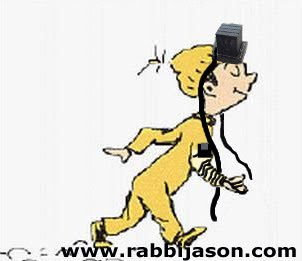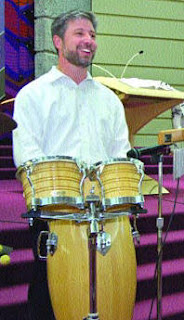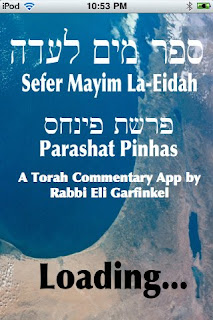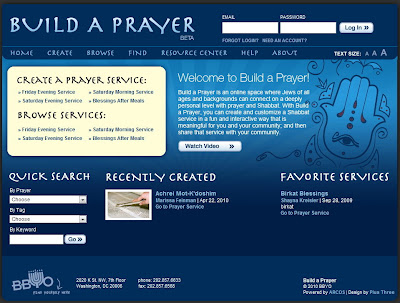Category: Prayer
Stand-up comic and blogger Heshy Fried wrote on his Frum Satire blog yesterday that shuls (synagogues) “in the New York metropolitan area are going to be charging premium prices for premium seats, like those with more legroom” in order to raise more money in these challenging financial times.
This got me thinking that synagogues aren’t really all that different than the airlines in this regard.
- Synagogues charge membership dues; Airlines have frequent flyer membership
- Synagogues pass out candies during the service (throw candy at bar mitzvah boy after successful layning); Airlines pass out food during the flight (don’t throw peanuts at pilot after successful landing!)
- Synagogues have Kiddush Clubs; Airlines offer Scotch too
- People doze off mid-service; People doze off mid-flight
- Synagogues charge more for good seats (by exit); Airlines charge more for good seats (by entrance)
- People pray in synagogues; People pray on airplanes (use tefillin at your own risk)
These comparisons really shouldn’t come as a surprise. After all, both industries are hurting financially right now and are looking to reinvent themselves in a competitive market. Is it really any wonder that the airline named Spirit is currently on strike?
Cross-posted at Jewish Techs
When it comes to Jewish prayer, there are two schools of thought: keva and kavannah. Keva means “rote” and refers to the fixed prayers that are set forth in the siddur (Jewish prayer book), while kavvanah is the free and spontaneous inner devotion of the individual.
Many Jewish youth groups and Jewish camps have tried to bridge the gap between the opposing principles of keva and kavannahby creating fresh and innovative prayer books for each service. For generations, Jewish teens, educators, and camp rabbis have spent hours photo copying prayers out of the standardized siddur and pasting them onto sheets of paper along with spiritual poems, catchy songs, motivational quotes, and clip art to make custom service booklets. The interweaving of traditional liturgical texts with hippie quotes and Debbie Friedman songs to create a specialized prayer book offers the keva of the siddur, but encourages the self-expression and spiritual spontaneity that is at the heart of kavannah.
Now the market leader in pluralistic Jewish youth programming, BBYO, Inc., has launched a web-based application to design custom-made prayer books. Build a Prayer, which took almost two years to develop and is being funded through a Jewish Funders Network grant, offers every text imaginable, from Hebrew, English translation, transliterated, traditional, and pluralistic. Service creators can choose from pictures, poetry or commentary, and then share or print the service for use with their community. MyJewishLearning.com partnered with BBYO and provided the educational content about Shabbat and prayer for the online Resource Center that is built into the site.
Build a Prayer isn’t only for the teenage members of BBYO. Matthew Grossman, the organization’s Executive Director said, “We hope Build a Prayer will be a valuable tool for the entire community; it is available to any organization, educator or teen who wants to produce creative worship experiences.”
After a guided tour of the Build a Prayer site by Michigan BBYO Director Eric Adelman, I played around with the many features and found it to be user friendly, interactive and intuitive. As someone who has created many custom prayer books and song sheets, and who likes a crisp, clean look, I really appreciated how professional looking the finished product turned out.
To learn more about the concept of BBYO’s Build a Prayer and to find out if the organization was worried that Jewish teens would miss the scissors and glue part of DIY siddur making, I posed some questions to Shayna Kreisler, the Director of Civic Engagement and Leadership at BBYO.
Who came up with the idea for the Build a Prayer site?
The original idea came out of the observation that at BBYO, we see teens and staff members creating relevant and powerful Shabbat services, but also feeling challenged since most of them have only experienced services within their own synagogue. This challenge is made more difficult since most teens aren’t comfortable in a traditional siddur – they don’t know where services start and end, what to include or what is “safe” to leave out. To meet that need, these worship services are typically guided by a teen-designed collection of songs, poetry and prayers that is compiled through an effort of photocopying, cutting and pasting together old song sheets and prayer book passages. As an organization, we saw the need to provide Jewish teens with an accessible place to explore prayer and its meanings – doing it online also happens to save some glue.
Was there a “grassroots” push from teens to create this resource?
I think that we were really responding to a need that we had been hearing from the field – BBYO, because we are not affiliated with a movement, does not have one single prayer book that we all use. Each region and community ends up making their own or creating new services for each chapter overnight, regional convention, etc. The teens that I work with on the International level were having issues finding the resources online, so while they did not know to ask for it directly, it was certainly a need that was being presented in the difficulties they were having in finding the appropriate resources.
Who runs the site?
BBYO runs the website, but we work in partnership with other organizations (currently, The Foundation for Jewish Camp and MyJewishLearning.com) and are looking to build more partnerships around the website. We really feel that this is a value added resource for the entire Jewish community for a plethora of uses – independent minyanim, youth movements, day and overnight camps, b’nai mitzvah students, parents of b’nai Mitzvah who may not be as familiar with the Shabbat service as they would like, educators working with teens or other age groups, and more!
What has the feedback been from teens?
The teens LOVE it. We have received some really positive feedback about the resource and how it has changed the way that people look at the Shabbat Service. Eventually we hope to add in holidays, the weekday service, a haggadah, etc. Most of the feedback we receive is from people saying that the site is great and it would be amazing if it could do x, y or z. We take the feedback very seriously, and we are trying to respond to the needs of the community. I encourage anyone who has any feedback to email us directly through the website.
Was there any concern that teens would feel nostalgic for the old-style cut and paste prayer books?
The BEST part of the website, in my opinion, is the content finder. Once you start to build a Shabbat service, and choose your languages, the type of service you want to create and your prayers, you can start to add in your own poems, lyrics, translations, thoughts, videos, audio, images – almost anything really! And all of that info gets stored in the content finder for others to utilize. The more people add in their own content, the more rich the website becomes as a tool. We really look at that piece of the website as a way for people to share their thoughts and ideas and their creative work with the entire community. In a way, buildaprayer.org takes the scissors and paste concept and brings it into the 21st century. I really do not think that we lose anything at all – I think it really opens up the Shabbat experience in a whole new way.
It is difficult to find a siddur that really fits an individual’s or a community’s needs completely, but with Build a Prayer it becomes much easier to make a custom fit prayer book that will encourage both keva and kavannah. On behalf of Jewish educators, youth group workers, and camp rabbis everywhere: Thank you BBYO!
Here is the video tutorial for the interactive Build a Prayer site:
Rabbi Gerry Skolnik taught my senior seminar in rabbinical school and I’ve continued to learn from him since graduating from the Jewish Theological Seminary (JTS) through his weekly column for The New York Jewish Week and now his blog called “A Rabbi’s World.”.
After hearing that an 86-year-old man crashed his Toyota into the front steps of Rabbi Skolnik’s synagogue, the Forest Hills Jewish Center, last week after the car’s accelerator stuck, I went to his blog hoping to get the rabbi’s first-hand account of how the Toyota gas pedal recall was affecting his synagogue in a very real way. But, instead of blogging about how this elderly man mistook the Queens synagogue for a drive-thru, Rabbi Skolnik wrote about another interesting topic: What happens to the daily minyan when there’s a blizzard? (He would have generated more traffic to his blog had he written about the Toyota recall instead of the minyan. I’m just saying.)
In his post titled Balancing Obligation and Common Sense, Rabbi Skolnik discusses the dilemma he faced after last week’s East Coast Blizzard (termed “Snowmageddon” by President Obama) when the treacherous driving conditions made it dangerous to hold the morning minyan (prayer services) at his Forest Hills congregation. He had to balance the obligation of saying the Mourner’s Kaddish (his mother passed away recently) and the obligation to not put one’s life (or his congregants’ lives) in unnecessary danger.
He writes, “Actually, there are discussions in the Talmud around the idea of ‘mitigating circumstances’ as they relate to prayer, but I don’t know of any that relate to blizzards.”
The need for a quorum of ten Jewish individuals (only Jewish men in Orthodox synagogues) in order for mourners to recite the Kaddish prayer is taken very seriously, and so the decision to cancel the minyan is a difficult one. Rabbi Skolnik explained his decision in his blog:
I decided that the obligation to safeguard one’s health under any and all circumstances can, in a situation like a blizzard, mean that one might not only be allowed to, but actually be required to stay inside, and not walk or ride to a synagogue during potentially dangerous weather – even if saying kaddish for a parent. There are other ways to honor the soul of the departed, most significantly, to study Torah. Kaddish is universally recognized as “what one does,” but there are other gestures of respect that elevate the soul of the departed closer to God.
While the snowfall in Michigan last week couldn’t rival the East Coast’s blizzard, the morning driving conditions were treacherous here too. But when I received an early morning text message from Rabbi Aaron Bergman of Adat Shalom Synagogue letting me know that I would be the tenth at the morning minyan, I jumped in the car and headed over. There’s something exhilarating about being #10 in a minyan and knowing that the mourners wouldn’t be able to fulfill their obligation without you. Driving down the snowy streets, I felt I was on an important mission (a police escort would have been helpful).
Traditionally, the daily minyan has been a very important part of Jewish life. But I also think my teacher, Rabbi Skolnik, made the right decision. While it is commendable that he wanted to honor his late mother with the words of the Kaddish prayer, I’m sure that she wouldn’t have wanted him to risk driving in those conditions. And so, by calling off the minyan he honored his beloved mother too.
Oh! The Plane’s Gonna’ Blow!
This is a poem I wrote about the incident last week when a Jewish 17-year-old boy caused a U.S. Airways flight to be diverted because the flight attendant thought his tefillin (phylacteries) were a bomb. It’s based on “Oh, the Places You Will Go!” by Dr. Seuss.
By Rabbi Jason Miller
(With Apologies to Dr. Seuss)
Mazel Tov!
On the plane you shall pray.
You’re off to Louisville!
Takin’ off from LGA!
 You have tefillin on your head.
You have tefillin on your head.
You’re travelin’ with New York Jews.
You can pray in any direction you choose.
You’re on your own. And you know what you know. If there’s turbulence, the Amidah you will forgo.
The flight attendant will see your odd boxes. Look’em over with care. Then she’ll say, “Hey Kid, whatchya’ got on over there.” With your arm full of leather and your shuckling feet, you’re too frum to take your seat.
She’ll tell the pilot the plane will go down. In that case, of course, you’ll head to a new town. Since your tefillin looked so silly, you’ll touchdown right in Philly. You’ll say, “The box on my hair? You really need not fear!”
Up there things can happen and frequently do, by people much more Middle Eastern than you.
And when things start to happen, don’t worry. Don’t stew. Just go right along. They’ll soon realize you’re a Jew.
Oh, the Plane’s Gonna’ Blow!
You’ll be on your way up!
You’ll let out a sigh!
You’ll soon join Bubbie for soup in KY.
You’ll be just fine because you’ll have prayed. The feds will say “Oops, Sorry!” for the mistake that was made. Wherever you fly, you’ll have learned quite the lesson. With tefillin no more will you be messin’.
Except when you do.
Fly El Al as a Jew.
Please promise us that you will no longer fear. These Hang-ups can happen when you fly U.S. Air.
You can get all hung up in a prickle-ly perch. And your gang will fly on. You’ll be left in a Lurch.
You’ll come down from the Lurch with an unpleasant phlum. And the chances are, then, that you will still be frum.
Oh, the plane’s gonna’ blow! There is prayer to be done! You must say thanks to your Lord. You’ve done the right thing son. And the magical thing you do with a leather strap, will make you the most famous Jewish chap. No Shame! No one will think you’re just a rube, the world will learn about tefillin on YouTube.
They still won’t get it. But you shouldn’t fret it.
I’m afraid that some times you’ll pray sans phylactery. On a plane, in a train, or by that Ol’ Factory.
Daven Alone!
Whether you like it or not, Alone will be something you’ll do quite a lot.
And when you’re alone, there’s a very good chance you’ll meet people scared by your Jewish way. There are some, down the road between hither and yon, that won’t know that a tefillin is what you lay.
Kid, innocent you are
And you’ll go far.
So… be your name Birnbaum or Schwartz or Levy or Mordecai Ale Van Allen O’Bevy, you’re off to Great Places!
Today is your day!
Your Bubbie is waiting.
So… daven away!
Glossary:
- Amidah = The central prayer in the Jewish liturgy, which is recited standing.
- Shuckling = Yiddish meaning “to shake.” The ritual swaying of Jewish worshipers.
- Frum = Yiddish meaning “religious.”
- Daven = Yiddish meaning “pray.”
I was in Israel staffing a Birthright Israel trip in 2004 when I learned about the Indian Ocean Tsunami while watching CNN in my Jerusalem hotel room. The following year, I was staffing a University of Michigan Hillel mission to Ukraine when the tragic news about Hurricane Katrina came on the news in my Kiev hotel room. I was therefore surprised that I learned of the devastation of the Haiti earthquake the other day while sitting in my own home, in the United States.
These natural disasters raise many challenging theological questions for us. The mere fact that we refer to these events as “acts of God” forces us to consider why God (whichever God we believe in) acts likes this — or why God allows these catastrophes to occur. Following the theology ascribed to Rabbi Harold Kushner, I would phrase the theological conundrum as: “How do we humans understand and relate to a God who doesn’t participate in these natural acts of devastation?” Because if these were really acts of the God in which I believe, I simply wouldn’t want that to be my God!
In the aftermath of the Indian Ocean Tsunami, I found some comfort in a prayer that Rabbi Jonathan Sacks wrote. I hope I also brought some comfort to others by reciting that prayer during that difficult time. Rabbi Sacks, the chief rabbi of the British Commonwealth, has adapted that prayer for the recent earthquake in Haiti.
As an introduction to the prayer penned by Rabbi Sacks, my teacher Rabbi Brad Hirschfield of Clal writes the following on his Beliefnet blog: How does one pray in the wake of this week’s events in Haiti? Or does that really beg the question of how we pray on any given day in the face of equally painful, if less grand, tragedies? I am not sure, and frankly right now, am not sure that I care.
Prayer in Response to Natural Disaster
By Sir Jonathan Sacks, Chief Rabbi
Adon ha-olamim, Sovereign of the universe,
We join our prayers to the prayers of others throughout the world, for the victims of the earthquake which this week has brought destruction and disaster to many lives.
Almighty God, we pray You, send healing to the injured, comfort to the bereaved, and news to those who sit and wait. May You be with those who even now are engaged in the work of rescue. May You send Your strength to those who are striving to heal the injured, give shelter to the homeless, and bring food and water to those in need. May You bless the work of their hands, and may they merit to save lives.
Almighty God, we recognise how small we are, and how powerless in the face of nature when its full power is unleashed. Therefore, open our hearts in prayer and our hands in generosity, so that our words may bring comfort and our gifts bring aid. Be with us now and with all humanity as we strive to mend what has been injured and rebuild what has been destroyed.
Ken Yehi Ratzon, ve-nomar Amen.
May it be Your will, and let us say Amen.
The Marley Minyan
In Jewish prayer there are some liturgical tunes known as “Mi-Sinai tunes.” Not that they are literally from Mt. Sinai, but the terminology expresses their authenticity. As the Congregation Emunath Israel website explains about the history of chazzanut (Jewish cantorial singing):
The Maharil was the Posek (Halachic authority) for the largest Jewish communities of the day – Worms, Speyer, Mayence, Regensberg, etc. He was upset at the “foreign” elements intruding in the melody of tefillah, and he set out to determine which versions were the true ones (Mi-Sinai or Scarbova). He was able to do that because of the Crusades that brought Jews from all over Europe to seek safety in the Rhineland. He examined the different musical strains, and determined which were authentic. His P’sak (Halachic ruling) – that “Ein L’Shanos” – one may not change the musical Nusach of a community, is standardized as Halacha by the Shulchan Aruch (Orach Chaim 619). You can, of course, see that in the Mishneh Brura as well. He was also responsible for standardizing Nusach Ashkenaz in the form that our Siddur takes…
Well, at the Jewish Theological Seminary’s Davidson School of Jewish Education (my alma mater), there is now a monthly prayer group that incorporates tunes that are not “Mi-Sinai” but more likely “Mi-Woodstock.” The JTA reports that this prayer group is “part guided meditation, part sing-along, part traditional prayer and part dorm-room musical jam that includes instruments ranging from guitars to didgeridos.”
My feeling is that this is what the Davidson School is all about: Jewish educators praying together, experimenting with tefillah, and finding the spiritual nexus between the Jewish liturgy (psalms, blessings, etc.) and popular music (Bob Dylan, Bob Marley, etc.). For those who would object to the use of musical instruments on Shabbat, rest assured that this “Jam Davening” takes place during the week.
 My teacher Rabbi Danny Nevins (right), who is the new dean of the JTS Rabbinical School, is a great drummer who has been hosting drum circles in his office for rabbinical students at the Seminary. The fusion of jamming and davening will bring more passion to JTS and by extension to Conservative synagogues. As evidenced by the popular Congregation B’nai Jeshurun (B.J.) synagogue on the Upper West Side of Manhattan, lively music during prayer draws crowds and helps bring people closer to God.
My teacher Rabbi Danny Nevins (right), who is the new dean of the JTS Rabbinical School, is a great drummer who has been hosting drum circles in his office for rabbinical students at the Seminary. The fusion of jamming and davening will bring more passion to JTS and by extension to Conservative synagogues. As evidenced by the popular Congregation B’nai Jeshurun (B.J.) synagogue on the Upper West Side of Manhattan, lively music during prayer draws crowds and helps bring people closer to God.
Jacob Berkman writes in the JTA article:
Jam Davening draws about double the audience of a typical learning minyan, participants say. Now the group is trying to figure out how to bring Jam Davening to a wider audience, first by inviting the broader seminary community into the minyan, then by taking the idea to individual synagogues. This comes at a time when music is rapidly being introduced into Conservative synagogues.
Musical instruments had been excluded from Conservative synagogues on Shabbat partially because of Jewish law and partially as a remembrance of the destruction of the Temple in Jerusalem nearly 2,000 years ago. But starting in the 1950s, the movement allowed Conservative congregations to decide for themselves whether to use instruments.
Now as the movement debates whether Jews should be praying for the rebuilding of the Temple or just Jerusalem — and about whether or not the use of electricity on Shabbat is banned — the use of instruments has also come under “healthy debate,” according to Rabbi Moshe Edelman, the director of the Committee on Congregational Standards for the United Synagogue of Conservative Judaism. Also, members of the Law Committee of the Rabbinical Assembly are working on a paper to address the issue, according to Rabbi Joel Roth, a professor of Talmud and Jewish law and formerly the head of the committee.
What do you think about Jam Davening? Leave your comments below.



